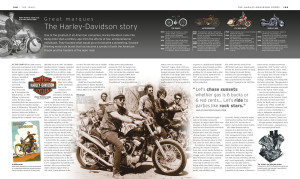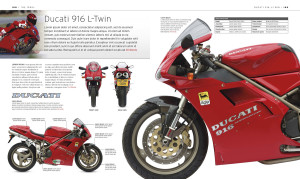When the ground-breaking “Art of the Motorcycle” exhibit opened at the Guggenheim Museum in New York City, in 1998, I had the good fortune of attending—twice. At the time, I was living in Philadelphia, a two-hour ride to the south via the mind-numbing New Jersey Turnpike, and a diehard enthusiast buddy of mine just happened to live in midtown Manhattan. Together we navigated the Big Apple’s anything-goes streets to the show and parked our bikes in the motorcycle-only parking area right out front, feeling like VIPs even though we were everyday riders.
Walking into the Solomon R. Guggenheim Museum and laying my eyes on the just-released MV Augusta F4, the stunning Massimo Tamburini-designed motorcycle that resurrected the legendary marque, the very example that was promised to motorcycle fanatic King Juan Carlos of Spain, is a moment in time forever imprinted into my moto-memory. Ascending the spiral main gallery of the Frank Lloyd Wright-designed building, with dozens of pristine examples of significant motorcycles laid out in chronological order, was a true feast for the senses. And the hefty, 427-page, hardbound, full-color catalog from that original show, with essays by Dennis Hopper, Hunter S. Thompson, Melissa Holbrook Pierson and others, which I lugged home in my backpack, remains the prize volume in my motorcycle book collection.
It is through this lens that I have evaluated the ambitiously titled book, Motorcycle: The Definitive Visual History. Edited by Mick Duckworth, a British motojournalist who has written books such as Norton Commando, Honda CB750 and Ace Times, among others, and released by United Kingdom’s DK Publishing, Motorcycle looks at the two-wheeled world from a European vantage point. It is written in the Queen’s English and uses European model names that occasionally differ from those familiar to Americans (e.g., Yamaha XJ6 Diversion instead of FZ6).

No book can include every single motorcycle that has ever been produced, so the editor must make choices, based on his own biases and within the publisher’s constraints. Readers with a longer historical view than mine will no doubt identify key omissions throughout the 20th century, but contemporary ones that stood out include the long-running Kawasaki KLR650 (a bike I own, so there’s my bias), the Yamaha GTS1000 with hub center-steering (Rider’s 1993 Motorcycle of the Year) and the revolutionary Britten V1000. The only two electric motorcycles in the book are one-off racing machines by MotoCzysz and Mission Motors, leaving production models like those from Zero and Brammo out in the cold. Movies like The Wild One, The Great Escape and Easy Rider warrant mentions, but On Any Sunday, a movie that helped catapult motorcycles into the mainstream in the 1970s, is conspicuously absent.
That being said, Motorcycle is overflowing with visual delights and historical details that will keep any enthusiast enthralled for hours. The chapters proceed as a historical timeline, starting with “Before 1920” and continuing on to “From 2000,” followed by a chapter on “The Engine” (how it works, types, significant examples) and a glossary. Within each chapter (1-2 per decade) are overviews of “Great Marques,” including Indian, Royal Enfield, Norton, Moto Guzzi, BMW, Harley-Davidson, Honda, Vespa, MV Agusta, Suzuki, Kawasaki, Triumph, Yamaha, Ducati and Aprilia, which provide a historical timeline, a narrative history and historical photos, ads, badges and more. There are also detailed “Profiles” on significant models, such as the Brough Superior SS100, Norton Manx, Honda CB750, Ducati 916, BMW K 1600 GT, among others, which includes numerous photos of the entire bike as well as details, a narrative history and specifications. Given that the book’s focus is on the visual, I really wish Motorcycle included profiles of the legendary men who designed great motorcycles—Phil Vincent, Edward Turner, Massimo Tamburini, Pierre Terblanche and Willie G. Davidson, just to name a few.
Again, within each decade, collections of motorcycles are organized into thematic groups covering a wide range of topics, such as Early Pioneers, America’s Golden Age, Mighty V-Twins, Out of the Mainstream, On Military Service, Scooters, Racers, Tourers, Superbikes, Design Diversity, Mile Eaters, Cruisers, and many more. Images of the motorcycles are laid out like a catalog, arranged in various sizes and accompanied by a listing of the year/make/model and a capsule description.

Throughout the book are two-page spreads of historical photos that capture the essence of two-wheeled life in its many forms: the Seattle Motorcycle Club in 1911; an illustrated Sunbeam ad from 1930 showing a motorcyclist impressing sunbathing ladies; a group of 26 Canadian dispatch riders in 1943, sitting on motorcycles arranged in a large circle, with their front wheels pointed towards the center; a painting from the 1969 movie Easy Riders; the 1972 Mint 400 desert race; the insane lean angles of ice speedway racing, very different from the kicked-out rear ends of racing on dirt; and an image of a small-displacement motorcycle in Cambodia pulling a taxi-trailer full of people—showing that motorcycles provide inexpensive, utilitarian transportation all over the world.
What makes a book like Motorcycle such a pleasure is that it can be looked at, flipped through, read, scrutinized and enjoyed over and over again, each time revealing some new nugget of information or a unique motorcycle that was somehow overlooked. Favorites can be pondered. Find-and-identify games can be played: Are motorcycles I have owned included? (Yamaha FZ750, Honda VFR740, Suzuki SV650—yes; Honda XR200 and Kawasaki KLR650—no.) Are motorcycles I have lusted after included? (Yes—many times!) Weirdest model names? (I found three named after rodents—Vincent Mighty Mouse, Scott TT Super Squirrel and Hodaka Super Rat.)
Covering 320 full-color pages in a hard-bound book that would look great on any desk, coffee table or book shelf, and including two frame-quality prints on heavy card stock, Motorcycle: The Definitive Visual History is a fascinating if not wholly complete journey through the world of two wheels, from the origins of motorcycles before 1900 to the latest-and-greatest models from the 2011 model year (plus a few early-release 2012 models, like the BMW K 1600 GT and Honda Gold Wing). Eye candy galore, it’s the perfect addition to a motorcyclist’s wish list.
FOR MORE INFORMATION:
$40.00, available from DK Publishing; also available from Amazon








My brother loves everything to do with motorcycles! Right now, he is saving up to buy his Harley-Davidson and so I am pretty sure that he would love to see the profile that is written on that bike in this book. Are there any bikes that are not discussed in Motorcycle: The Definitive Visual History?